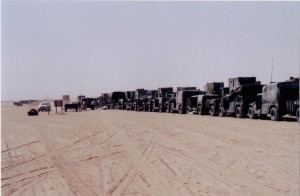 We crossed the border from Kuwait into Iraq in one long column of vehicles. My ambulance rode somewhere in the middle. No children lobbed grenades our way. Our most present enemies proved to be broken vehicles and incompetence. Every breakdown meant that while the mechanics repaired the trucks my teammate Cory and I would hunker down on one knee alongside our ambulance and watch the desert. I no longer recall my precise daydreams while gazing across that featureless golden expanse. I’m sure they involved ambushes and firefights, captures and escapes, probably a romance with a beautiful Iraqi woman. An idol of my early childhood was Conan the Barbarian and I still picture myself as a sword-wielding barbarian sometimes. The blank slate of that desert is a good place for daydreams. The holy trifecta of active daydreaming, drinking Red Bull and chewing tobacco kept me awake and nominally alert through hundreds of miles of convoys. Terrible habits, the last two, but effective.
We crossed the border from Kuwait into Iraq in one long column of vehicles. My ambulance rode somewhere in the middle. No children lobbed grenades our way. Our most present enemies proved to be broken vehicles and incompetence. Every breakdown meant that while the mechanics repaired the trucks my teammate Cory and I would hunker down on one knee alongside our ambulance and watch the desert. I no longer recall my precise daydreams while gazing across that featureless golden expanse. I’m sure they involved ambushes and firefights, captures and escapes, probably a romance with a beautiful Iraqi woman. An idol of my early childhood was Conan the Barbarian and I still picture myself as a sword-wielding barbarian sometimes. The blank slate of that desert is a good place for daydreams. The holy trifecta of active daydreaming, drinking Red Bull and chewing tobacco kept me awake and nominally alert through hundreds of miles of convoys. Terrible habits, the last two, but effective.
When it came our turn to play the part of the broken vehicle, it happened on account of a blown tire. Naturally, we had trained for just this sort of occasion. The protocol was to call in our situation on the radio, stop the convoy and take up defensive positions while the vehicle was either repaired, or if it could not be repaired in a reasonable time, destroyed. At the sound of the flat tire slapping against the pavement, we slowed our ambulance, radioed ahead and began to pull over to avoid further damage to the wheel.
“Hold tight, medics,” was our only reply. We watched the other vehicles in the convoy pass by and disappear into the shimmering heat of the cement. Minutes grew longer, and the only vehicles of any sort that saw were the occasional civilian car or pickup truck, the latter consisting mostly of white Datsuns. We watched each one approach, nervous of what it might bring us. But each one passed us by, drivers and passengers shooting us looks of wary confusion, while we just stood on the side of the road like perfect assholes. At some point, our convoy commander radioed us to say that the convoy was turning around, but after thirty minutes of waiting, we decided to believe him only when we had more evidence.
It sounds shocking, but in light of some of our pre-deployment training, our current situation might be slightly less than surprising. The high point of our pre-deployment training had been going on a virtual convoy. This event took place in shipping containers that had been outfitted with real hummvees and whose walls were covered with screens on which we could see our CGI surroundings. We would sit in the vehicles and the images on the screens would reflect our reactions while driving, rotating appropriately with our turns and changes in speed. Each container housed one vehicle and we could see the video game representations of the groups in the other containers. The graphics weren’t stunning, but overall, it was probably the most sophisticated thing that I had ever seen used in the army.
We ran through a couple quick simulations to get ourselves used to interacting with the virtual environment. There were a couple of communication glitches between containers and we spent most of that downtime cracking jokes to stave off boredom. During one such interval, my crew decided to change positions for a little unplanned cross-training. When the next simulation began, I found myself as a medic manning the 0.50 caliber machine gun mounted on the top of the truck in contradiction to at least one of the Geneva Conventions.
We drove briefly through the virtual desert and then lurched through a series of two-dimensional urban settings before the action started. Our attackers came at us on the fringes of a crowded
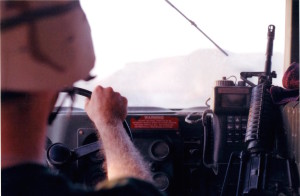
View from the ambulance cockpit.
market and continued to pop out whack-a-mole style from alleyways and rooftops as we zig-zagged through the city towards our goal, a UN-run hospital. I was enjoying myself in the gun turret, swiveling from side to side, squeezing the trigger of the world’s biggest joystick. It was great. We were all laughing, joking, the guys in the truck were leaning out of the windows like a bunch of camouflaged Indiana Joneses. The driver spun the wheel hard to the left, the images on the screens swiveled forcefully to match and a large building came into view straight ahead of us.
“Oh shit, they got guns!” someone shouted.
“I got ‘em!” I shouted back and unleashed virtual hellfire into the group of digital armed men. The screens stopped moving, which we interpreted as either another technical glitch or a mission complete, both of which signaled a break. Amidst laughter and high-fives, someone asked; “did they have blue helmets?”
You see, UN soldiers distinguish themselves by blue helmets. I then remembered that our simulated destination had been a UN-run hospital.
It was then that the door to our container burst open to reveal the stocky silhouette of the sergeant in charge of the training operation.
“What the fuck?!” was all he shouted, in wide-eyed disbelief. “Just what the fuck!?”
Our day of training ended shortly thereafter and several months later, Corey and I found ourselves standing alone alongside a broken humvee in the Iraqi desert. Some of the trucks from our convoy did eventually return for us. It might have been an hour or so that we waited, although the distortion of my memory stretches it into several. The command vehicle, which is to say the vehicle carrying the convoy commander, led a wrecker with a tow bar and a gun truck. Their plan was to tow our vehicle to where the convoy would stop for the night. Lost to my memory is the reason why we didn’t simply change the tire. I’ll assume that for whatever reason, we simply didn’t have a spare available and none was brought by the rescue party.
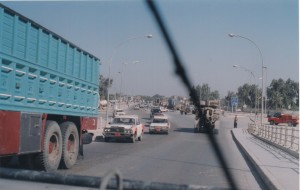
View from the cockpit, the wrecker slightly obscured by a windshield wiper.
The plan was to tow our ambulance along with the rest of the convoy and to do this, the wrecker first had to turn around on the highway. As wreckers are rather long vehicles and the highway consisted of only two lanes, this involved executing a multi-point turn in a garish homage to Austin Powers making a 67 point turn on a luggage car in a narrow hallway. This simple plan backfired when the wrecker ran over the guardrails that ran along the side of the road. With a steel support post now angled forward underneath the engine, the driver began to back up to make the next point in the turn, oblivious to our cries for him to stop. In an instant, the truck’s radiator became impaled on the steel post, gushing fluid onto the sand and cement and doubling the number of trucks that needed to be rescued. The sergeant in charge of the command vehicle turned out to be none other than the same sergeant who had witnessed us gun down the virtual UN soldiers. He now rushed to control this situation, calling for more support and giving orders for our ambulance to be lashed to his vehicle.
It is important to note here that we had blown a rear tire, making it important to attach the rear of our vehicle to any truck that would tow us, thereby allowing our truck to roll on its front tires. This was not a point that we could impress upon the sergeant in command. After being told to shut the fuck up and not get in the way, we calmly watched the nose of our ambulance get hooked up to the back of the command vehicle. Another wrecker soon arrived to tow the first one. It executed a 180degree turn without injury, hooked itself to the first wrecker and away we went. Corey and I were ordered to ride in the open back end of the truck towing ours. We shrugged and obeyed, clambering on top of some rucksacks and securing ourselves to the tow vehicle by a measly canvas strap. With the ambulance hooked up and ourselves minimally secured, our rescue truck sped forward at a solid 50mph to catch up with the rest of the convoy. For Corey and I, clinging to the truck to avoid slipping our canvas strap immediately became a full-body workout. Fortunately our exercise was brief, cut short by the predictable shower of sparks erupting like the tail of a comet from the ambulance’s wheel, which was quickly stripped of its rubber and reduced to a hot mess of burned and bent metal.
The phrase “I told you so” is never a welcome one and so Corey and I stood dumbly to one side while the sergeant made the necessary changes to the towing set-up. The drive to what was to become our base was a three-day affair and the vehicle breakdowns proved not to be our only incidents.
When the ambush that we had all been told to expect finally occurred it was not what any of us had expected. While driving through al Iskanadariya the following day, Corey and I started hearing a clicking noise coming from the rear of the ambulance on the driver’s side. It was an arrhythmic clicking noise and we began to debate what part of the truck might be breaking down now. I could hear voices on our radio, but couldn’t make the words out clearly. Clarity came very suddenly with the phrase “Hey medics, maybe you want to return fire?”
I looked at Corey. “Hey man, is someone shooting at us?”
He looked at me, then into his side view mirror.
“Holy shit!”
Behind our vehicle and alongside the convoy, were a car and a white pick-up truck, the passengers of which were firing at us. Before we could react, the vehicles peeled off the highway and onto a small side street. Although I almost immediately lost sight of them, our convoy commander, who I assume hadn’t, ordered us to change course. Several turns later, we stopped in front of a large villa, dismounted our vehicles and took up defensive positions, with some of us watching the house (for what, exactly, was never made clear) and the others keeping an eye on our surroundings, which largely consisted of the desert and a lot of angry drivers stopped in traffic.
It’s worth mentioning that we had established standard operating procedures how to react to an ambush
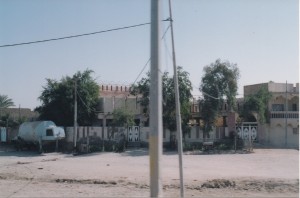
The house we watched.
during a convoy and that absolutely none of those procedures involved stopping the convoy. In fact, if the entire set of convoy ambush instructions had to be summed up by one key sentence, that sentence would probably be “Don’t stop the convoy.” Since in this particular ambush, none of our vehicles had been disabled, no one had been wounded and the assailants were no longer even present, one might think that not stopping the convoy should be a very natural course of action. Of course, thinking, as we say in the army, can get you in trouble, so there were crouched in broad daylight outside somebody’s home. Presumably the home of the ambushers, but really, who knows? If we’re being honest, I have to admit that I did find the idea of storming a house pretty exciting. It was not to be, however, and eventually, I had to trade in my daydreams of close-quarters combat for the harsh reality of sweat, boredom and knees stiffened from crouching alongside my vehicle.
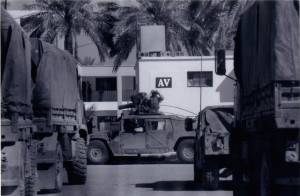
Life in the army is and probably always has been about hurry-up-and-wait. I suppose I should have known better than to expect war to be any different. After sweating on the side of the road for enough time to have allowed our attackers, if they were even inside, to have showered, cooked dinner and watched a movie, our commander ordered us back into our vehicles and away we drove.
In keeping with our theme of self-made problems, we did have one final misadventure before arriving at our base in al-Habaniya. The night following our slow and pointless stakeout, we camped out in our vehicles at a truck stop that had been converted into a fuel depot for American vehicles. The nights were fairly warm and most of us laid out on the tops of our vehicles. An unobstructed view of the starry night sky was considerably better than the view offered by staying within our vehicles, bulletproof though they may be. The camp was therefore littered with legs dangling from pillow-strewn hummvee roofs. One of those legs belonged to a certain Sgt. Silva, who had the misfortune of being backed into by the truck in front of his, resulting in broken tibia. Corey and I treated him and brought him to a nearby field hospital.
The next day, we finally arrived al-Habaniya, at al-Taqqadum, the former Iraqi air force base that was to become our home for the better part of the next nine months. We showed off the bullet
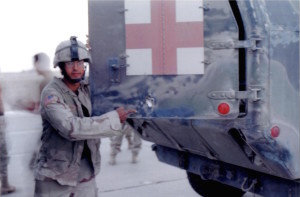
Corey showing off our first war wound.
marks on our ambulance and traded stories with the soldiers who had arrived ahead of us. While sorting out our ambulance parking and barracks situation, I tallied up my accomplishments in Iraq to date: I had been abandoned on the side of the road by my own unit, shot at without having been aware of it, experienced boredom and discomfort staking out a house and treated one non-combat-related injury. War is hell.
 We crossed the border from Kuwait into Iraq in one long column of vehicles. My ambulance rode somewhere in the middle. No children lobbed grenades our way. Our most present enemies proved to be broken vehicles and incompetence. Every breakdown meant that while the mechanics repaired the trucks my teammate Cory and I would hunker down on one knee alongside our ambulance and watch the desert. I no longer recall my precise daydreams while gazing across that featureless golden expanse. I’m sure they involved ambushes and firefights, captures and escapes, probably a romance with a beautiful Iraqi woman. An idol of my early childhood was Conan the Barbarian and I still picture myself as a sword-wielding barbarian sometimes. The blank slate of that desert is a good place for daydreams. The holy trifecta of active daydreaming, drinking Red Bull and chewing tobacco kept me awake and nominally alert through hundreds of miles of convoys. Terrible habits, the last two, but effective.
We crossed the border from Kuwait into Iraq in one long column of vehicles. My ambulance rode somewhere in the middle. No children lobbed grenades our way. Our most present enemies proved to be broken vehicles and incompetence. Every breakdown meant that while the mechanics repaired the trucks my teammate Cory and I would hunker down on one knee alongside our ambulance and watch the desert. I no longer recall my precise daydreams while gazing across that featureless golden expanse. I’m sure they involved ambushes and firefights, captures and escapes, probably a romance with a beautiful Iraqi woman. An idol of my early childhood was Conan the Barbarian and I still picture myself as a sword-wielding barbarian sometimes. The blank slate of that desert is a good place for daydreams. The holy trifecta of active daydreaming, drinking Red Bull and chewing tobacco kept me awake and nominally alert through hundreds of miles of convoys. Terrible habits, the last two, but effective. Life in the army is and probably always has been about hurry-up-and-wait. I suppose I should have known better than to expect war to be any different. After sweating on the side of the road for enough time to have allowed our attackers, if they were even inside, to have showered, cooked dinner and watched a movie, our commander ordered us back into our vehicles and away we drove.
Life in the army is and probably always has been about hurry-up-and-wait. I suppose I should have known better than to expect war to be any different. After sweating on the side of the road for enough time to have allowed our attackers, if they were even inside, to have showered, cooked dinner and watched a movie, our commander ordered us back into our vehicles and away we drove.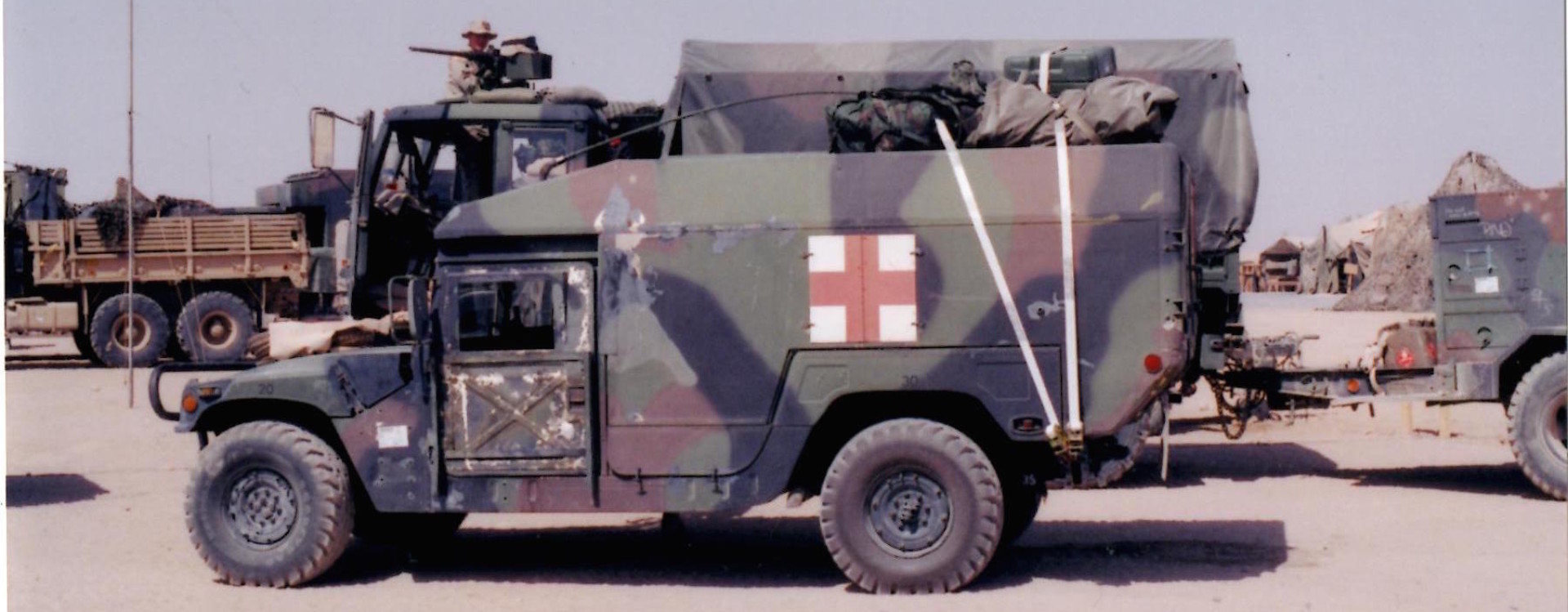




One thought on “2. The Invasion”